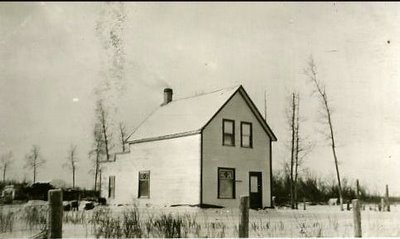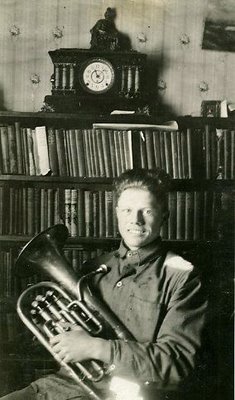
This farmhouse is in West Favelle, Minitonas, Manitoba. My father’s caption says, “Winter comes in October.” The date is October, 1919. This is not prairie, but rather scrubby brush that shelters bears and moose. The first winter, when money was short, they subsisted largely on canned moose.

The bears, like the Strachans, climbed the poplars. The Strachans, unlike the bears, climbed each other, the house, and whatever else there was. Growing up on the horizontal, they were fascinated by the vertical. This caption says, “Looking at the claw marks after a bear climbed this tree.” They did a bit of logging and a photo of a wagon-load of logs notes that the biggest log they cut was 27” across.
This house is taller than the South Dakota house and the added-on shed has a stepped roof (or edge) instead of slanted. The chimney is at the shed end of the house, so maybe the kitchen is in the shed, sharing the chimney with a heating stove in the front. Note the stained glass embellishment on the upper parts of the windows. (I’m impressed that in English movies the houses always have lots of stained glass, so maybe it’s an English predeliction.) Again there’s no porch.
Winter here was very hard. My father remembered it as a constant round of carrying out ashes and clinkers to put on the paths to sheds and outhouses and then carrying in more coal. There are always coal deposits on the high prairie if you know where to look. Even in the mild climate of Portland, OR, he would not give up the coal furnace, even after it became impossible to buy coal. (Finally my mother had the furnace removed while he was out of town.)

Even far to the north indoors was snug and safe. The result of having four nearly-grown children in a house this size was that things were a tiny bit crowded. In this house most photos were taken against this bookshelf with the mantel clock at the top, which I take to be a substitute because they are heating with a stove rather than an inefficient fireplace. Still, this family considered writing as important as fire. The mantel clock continued on to May’s household eventually, and the Bruce Strachan’s also had a plainer one which wasn’t sold until my mother died in 1999. The clock in this photo has a bronze portrait of a seated woman at the top, wearing Greek draped clothing. Probably she is meant to represent “Wisdom,” though I think I was once told she was “Minerva,” approximately the same thing. The books in the shelves look to be bound reports rather than popular books: the size of typing paper, but slim.
Mircea Eliade and other writers have pointed out that what the family values often becomes a kind of household altar: a piano, a staircase, a big window, a fine painting. In this house it’s pretty clear that classical time and books are the sacred objects. One photo after another is taken with this book case as background. (The camera case is hanging to the far right next to the calendar. I remember it from my own childhood. It was a bellows camera that made "post card" photos.) Of course, part of the reason is that this is an available-light time-exposure, so the windows need to be behind the camera or the result will only be silhouettes.
The sibs are probably doing homework -- May actually typing! But the caption says, “The family holds court.” That’s just a way of saying everyone is there and attentive, but it does look rather as though Bruce is the judge, sitting up high, May is the court stenographer and the two boys -- well, are they culprits or lawyers? Maybe they combine and swap the roles. They were in cahoots quite a lot.

Here’s Glenn with his horn, seated in front of the domestic altar. One can see the goddess and the sacred texts -- not quite the titles on the spines. Or maybe you have sharper eyes than mine.
The Strachan families that resulted from these sibs did tend to be self-contained and to feel that they were special, just by being Strachans. They were literate, they all worked hard on the farm, they saw nothing but progress ahead. No one had a clue that the youngest boy, Seth, with his love of heights, would end up as a bomber and transport pilot (B52's and B59's) in World War II, though they had admired the barnstormers in their little canvas and bamboo flying machines when they visited South Dakota prairie after WWI.

This photo actually begins a different essay, about touring the West in a homemade RV, probably funded by the estate of Archibald. I'm unsure whether this is the back of the same house, improved with a second chimney and porch, or simply another house. There are many hints about economic problems: good crops lead to low prices, you know.
No comments:
Post a Comment